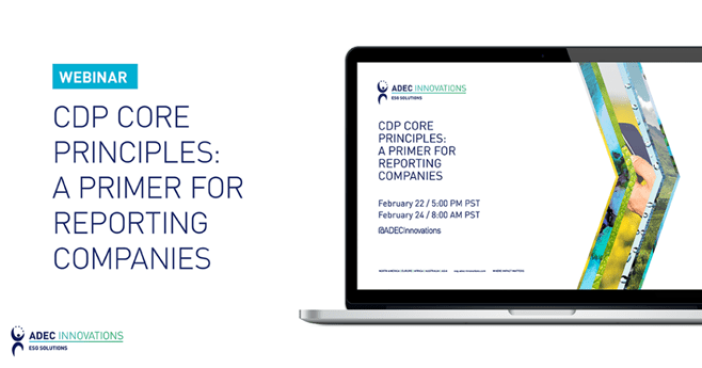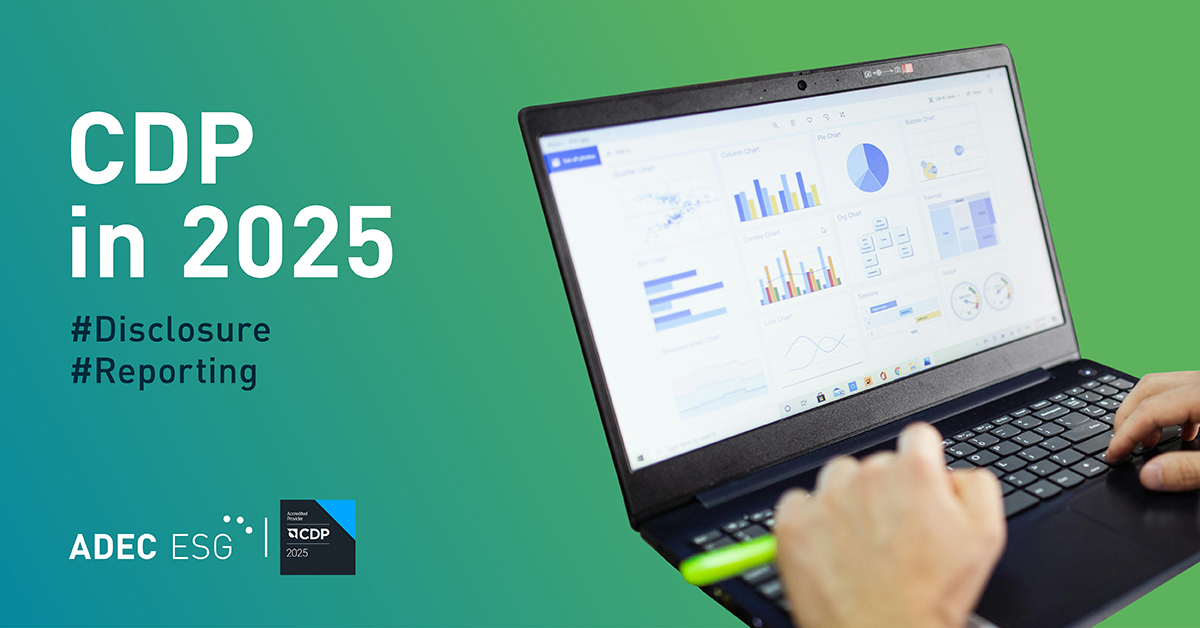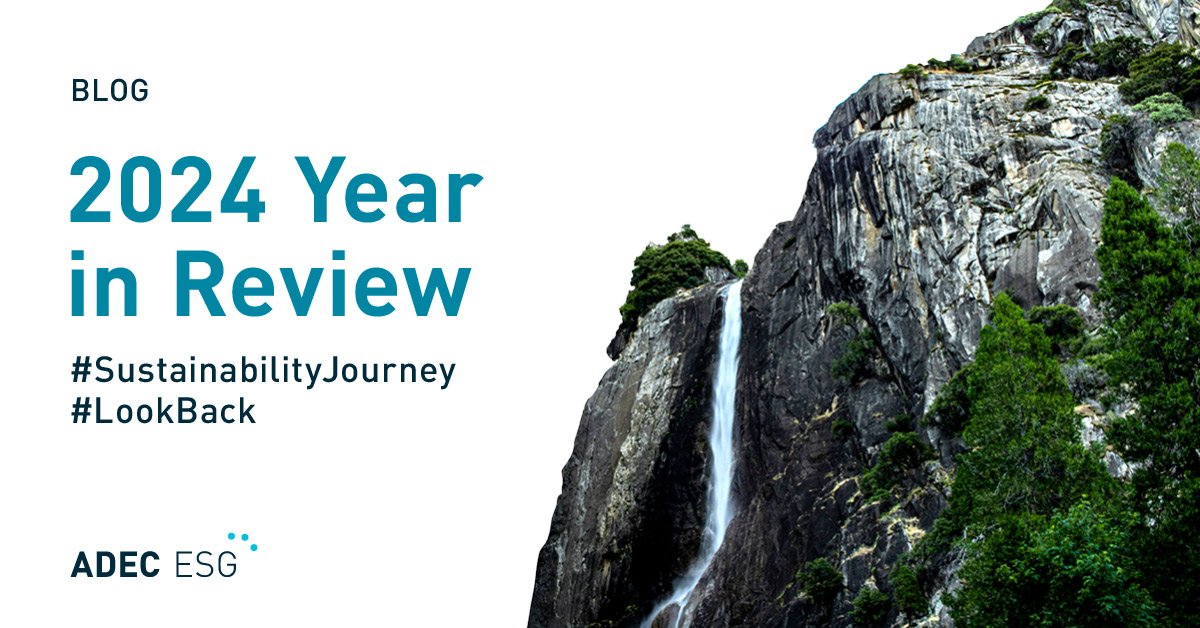The webinar began by diving into the basics of CDP Principles and common errors we see companies encounter. These common pitfalls include:
- Leaving cells/questions blank
- Referencing other cells/questions/external websites
- Not directly answering the question/criteria
- Not providing company-specific details
- Not providing case studies/examples
In the webinar, we provide detailed examples of each and review how you might avoid and combat these pitfalls.
Want to learn more? Watch the full webinar here.
Trends with CDP
As sustainability concepts evolve, the CDP questionnaire has become more robust and common trends arise. Our experts take you through what to expect for 2021—not only within the context of CDP, but also how you might reassess and redevelop your own ESG programs. We address critical questions such as how to leverage and improve ESG programs to maximize your CDP score and how to use CDP to improve your programs.
What to expect in 2021:
Sector-specific questions. Questions are becoming more geared towards individual sectors, focusing on the metrics you should be tracking and what is important to your investors. These types of questions also serve as a benchmark among others in your industry, helping you understand where your company falls in those sectors.
Stakeholder engagement. CDP puts a strong emphasis on whether or not companies are engaging with stakeholders—not only does this include investors but also customers, employees, local communities, and other key members of your value chain. You can maximize your score if engagement is more robust, whether it be through your customers, suppliers, or other parties. It’s important to fully understand your own climate impacts—and this extends beyond your own internal operations.
Science-based targets. This continues to be a hot topic and an increasingly large part of CDP. The Science Based Targets initiative now has over 1,200 companies who have committed to set targets that translate into action consistent with achieving a net-zero world by 2050.
Low-carbon transition plans. CDP will be asking more questions on this as they take a more holistic view. Determine whether these plans are regularly discussed within your organization. Are they implemented in your overall strategies?
COVID-19. The pandemic has completely transformed how many businesses operate across every industry. In your CDP response, you now have an opportunity to discuss how the ongoing global crisis has impacted your organization—and how you have adapted.
These are trends that we are seeing leading companies incorporating into their climate-related strategies and public responses. Want to get the full picture on CDP trends and updates to look out for this year? Watch the full webinar here.
Beyond CDP: Leveraging your sustainability programs to maximize your CDP score
In “CDP Core Principles,” our ESG consultants walk you through how you can effectively increase your CDP score by leveraging your existing sustainability programs.
Board-level engagement
Engaging the board and senior management in climate action and climate-related issues is an important factor, as it demonstrates executive accountability for these types of issues. Are your targets tied to climate issues, and are they fully integrated into your business strategy? Board-level engagement can help drive important change, give your company a sense of tone and direction, and help improve engagement from top to down. We go into detail on how you can engage in sustainability initiatives at the senior management and board level.
Risk & Opportunity Assessments
A significant part of the CDP questionnaire (and other reporting frameworks) addresses how you have identified key climate-related risks in your own operations, value chain, and overall business model. It is important to identify the why, what, and where of how these items are being assessed.
These questions apply to physical risks, transitional risks, and opportunities. Physical risks of climate change can include higher temperatures, sea level rise, increased frequency of extreme weather events, and so on. Transitional risks might include what risks your company incurs while transitioning to a low-carbon economy as well as changing consumer behavior and trends.
On the opposite side, opportunities might include ways in which your company may be able to realize benefits from climate-related issues, such as resource efficiency, access to new markets, or increased resiliency in response to climate change.
Watch the full webinar here to get a deep dive into key areas of the questionnaire that you may need to focus on.
Climate Scenario Planning
Climate scenario planning is a method for developing strategic plans that are more flexible and robust to a range of plausible future states. In fact, you may already be using types of scenario planning to evaluate impacts to other parts of your business.
Climate change creates uncertainties, and many different scenarios may arise as a result. How will each of these different scenarios impact your business? What factors are you considering as a part of each scenario? It is important to give clear reasoning as to why you have applied various assumptions and inputs as part of your analysis, building off risk assessments.
In the full webinar, we discuss why you should provide clear details on the thresholds or timeframes of your analysis and what was the outcome of playing out these scenarios. Did it inform on any decision making? We detail this process and explain how you can develop this in the form of a case study using the STAR method.
Connecting CDP to other ESG reporting frameworks and ratings
In the ESG sphere, there can be an overwhelming number of frameworks and indices to which companies report. However, many of CDP’s Core Principles carry over to other reporting frameworks and indices, as well- making it more feasible to expand your reporting initiatives.
GHG Inventory. All of the reporting frameworks we discussed, (e.g. EcoVadis, GRI, MSCI, etc.) include questions about how GHG emissions are tracked and managed.
Target/KPIs. Most indices and frameworks are looking for specific targets and KPIs. They’re also interested in how you are setting those targets and how you are tracking progress. For instance, EcoVadis looks at targets and goals and how you measure progress towards those targets.
Risks and opportunities. How are you mitigating risks and seizing opportunities? Risk and opportunity analyses are also a key part of many reporting frameworks. Your response to CDP can apply across others—for instance, DJSI also asks for the top risks that could impact your business.
Case studies and mitigation measures. These are key in satisfying framework requirements that look at specific actions your organization is taking. In the webinar, we discuss how it is vital to provide context about whether a risk, opportunity, or mitigation measure is specific to you. Where there are no goals or targets in place, it is always best to disclose what current operations look like and forecast how you plan to proceed.
Investors and other key stakeholders have made transparency a priority. Frameworks like CDP shed light on what your company is doing and provide a narrative for your goals, action, strategy, and reasoning. This company-specific data can be used across other ESG reporting frameworks and ultimately help you maximize your score by providing robust context.
Ready to learn more? Watch the full webinar here to get a more detailed picture on understanding the CDP Core Principles and how things are changing in 2021.




